Despite the struggling economy, green and sustainable practices are popular just about everywhere, from the average home to college campuses. While many of these solutions require a bigger investment up front, the savings they promise long term are often attractive enough to encourage and inspire many businesses and organizations. Many institutions see them as not only a great money-saver, but one possible way to launch their campuses into the next decade. If you're a current college student, you may have already noticed some of these green design trends coming to your school. Whether it's a brand-new, LEED certified building or community garden that produces fresh food for the cafeteria, more and more colleges are taking the plunge and designing more practical and sustainable campuses. Here, we've listed some of the biggest and most popular green design trends they're wielding today. If your school hasn't already implemented some of these measures saving energy and money, they more than likely have some plans in the works involving at least one.
-
Green rooftops
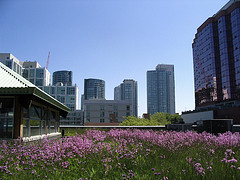 Green rooftops have enjoyed enormous popularity on college campuses across the country. So what are they? It's when a building's rooftop is covered with grass, plants, trees, shrubs or any combination of the above rather than just asphalt or concrete. Green roofs are for more than aesthetics, as they help control storm water runoff, create a place for wildlife, insulate buildings from heat loss and gain and reduce sound transmission. With so many benefits, they are becoming a popular choice for schools like the University of North Carolina-Chapel Hill, University of Southern California and University of Illinois-Chicago.
Green rooftops have enjoyed enormous popularity on college campuses across the country. So what are they? It's when a building's rooftop is covered with grass, plants, trees, shrubs or any combination of the above rather than just asphalt or concrete. Green roofs are for more than aesthetics, as they help control storm water runoff, create a place for wildlife, insulate buildings from heat loss and gain and reduce sound transmission. With so many benefits, they are becoming a popular choice for schools like the University of North Carolina-Chapel Hill, University of Southern California and University of Illinois-Chicago. -
Biodiesel vehicles
 As anyone who drives a car knows, gas is expensive. These costs can be especially large for campuses maintaining a vehicle fleet or surrounding towns providing public transportation to meet student needs. That's part of the reason so many campuses turn to biodiesel, which is, on average, about 12 cents cheaper than the traditional variety. Made from renewable sources (usually vegetable oil, but sometimes animal oil as well) rather than refined from crude oil, biodiesel offers schools a way to save money and the environment at the same time. In 2004, Harvard became one of the first US universities to start using biodiesel in campus vehicles and equipment. Over the past few years, it has used over 350,000 gallons to power busses, waste trucks, mail service and more. Other schools turning to biodiesel include the University of Colorado, Clemson University, the University of Michigan, The University of Idaho and North Carolina State University.
As anyone who drives a car knows, gas is expensive. These costs can be especially large for campuses maintaining a vehicle fleet or surrounding towns providing public transportation to meet student needs. That's part of the reason so many campuses turn to biodiesel, which is, on average, about 12 cents cheaper than the traditional variety. Made from renewable sources (usually vegetable oil, but sometimes animal oil as well) rather than refined from crude oil, biodiesel offers schools a way to save money and the environment at the same time. In 2004, Harvard became one of the first US universities to start using biodiesel in campus vehicles and equipment. Over the past few years, it has used over 350,000 gallons to power busses, waste trucks, mail service and more. Other schools turning to biodiesel include the University of Colorado, Clemson University, the University of Michigan, The University of Idaho and North Carolina State University. -
Natural light
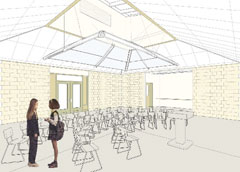 It doesn't make sense to pay for what you can get gratis, something many schools realize as they try to cut back on energy usage and costs. Much of the new construction on college campuses these days makes use of the ample natural light surrounding us rather than fluorescent bulbs. One particularly amazing system is called "the halo."It takes natural light and diffuses it throughout the classroom so that even on an overcast day, everything feels bright. At night, the system uses the same method to amplify man-made light, using about half the energy of a normal classroom for the identical amount of light. There are numerous schools using the halo and others like it, including the California College of Arts-San Francisco and Sierra Nevada College. Besides saving energy and money, it has been shown that more natural light may actually improve academic performance and productivity and reduce depression– some undeniably positive benefits!
It doesn't make sense to pay for what you can get gratis, something many schools realize as they try to cut back on energy usage and costs. Much of the new construction on college campuses these days makes use of the ample natural light surrounding us rather than fluorescent bulbs. One particularly amazing system is called "the halo."It takes natural light and diffuses it throughout the classroom so that even on an overcast day, everything feels bright. At night, the system uses the same method to amplify man-made light, using about half the energy of a normal classroom for the identical amount of light. There are numerous schools using the halo and others like it, including the California College of Arts-San Francisco and Sierra Nevada College. Besides saving energy and money, it has been shown that more natural light may actually improve academic performance and productivity and reduce depression– some undeniably positive benefits! -
Centralized heating/chilling plants
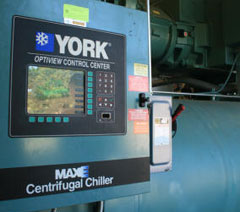 Many college campuses have heating and chilling plants that work for one or just a couple of buildings. It has been discovered, however, that it's more efficient to employ a single heating/chilling plant for the entire campus. These provide both the steam needed for heat, hot water and humidification as well as cooled water for chilling and dehumifidifying buildings. While this might not be a change you'd notice, it is becoming a more popular choice for schools going green. University of Wisconsin-LaCrosse and University of Pennsylvania are embracing the energy-saving benefits of centralized systems.
Many college campuses have heating and chilling plants that work for one or just a couple of buildings. It has been discovered, however, that it's more efficient to employ a single heating/chilling plant for the entire campus. These provide both the steam needed for heat, hot water and humidification as well as cooled water for chilling and dehumifidifying buildings. While this might not be a change you'd notice, it is becoming a more popular choice for schools going green. University of Wisconsin-LaCrosse and University of Pennsylvania are embracing the energy-saving benefits of centralized systems. -
Solar power
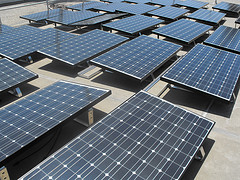 While you might not notice centralized heating and chilling plants, you'll more than likely know if your school decides to go solar. It may not be able to power the entire campus, but panels can provide for individual buildings– sometimes enough so they no longer need to use outside energy sources. One school experimenting with solar is Cornell, whose outdoor education program came up with a method of powering a popular outdoor activity with nothing else. Of course, solar isn't the only alternative energy method catching on at schools, as others employ geothermal power as well – a method that can cut energy costs by 30% to 70%. Leading the way are schools like Ball State University, who has reported saving over $2 million a year with the new geothermal system.
While you might not notice centralized heating and chilling plants, you'll more than likely know if your school decides to go solar. It may not be able to power the entire campus, but panels can provide for individual buildings– sometimes enough so they no longer need to use outside energy sources. One school experimenting with solar is Cornell, whose outdoor education program came up with a method of powering a popular outdoor activity with nothing else. Of course, solar isn't the only alternative energy method catching on at schools, as others employ geothermal power as well – a method that can cut energy costs by 30% to 70%. Leading the way are schools like Ball State University, who has reported saving over $2 million a year with the new geothermal system. -
Recycled building materials
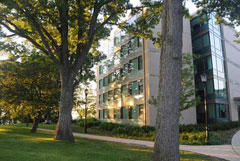 Schools are finding new and ever more inventive ways to use recycled building materials these days and, in many cases, students wouldn't even know about it unless someone told them. One of the most common is carpet made from old plastic bottles, though there are many other options out there. Take Ed Roberts College, for example. In addition to using such carpet, they also employed recycled milk cartons to build guardrails and bulletin boards. And campuses aren't just using recycled materials in new construction. Many are also making sure that when they tear down old buildings, they reuse or recycle the materials. One great example of this is at Carthage, where the school recycled 85% of their former natatorium, even using some of the old materials when constructing a student union.
Schools are finding new and ever more inventive ways to use recycled building materials these days and, in many cases, students wouldn't even know about it unless someone told them. One of the most common is carpet made from old plastic bottles, though there are many other options out there. Take Ed Roberts College, for example. In addition to using such carpet, they also employed recycled milk cartons to build guardrails and bulletin boards. And campuses aren't just using recycled materials in new construction. Many are also making sure that when they tear down old buildings, they reuse or recycle the materials. One great example of this is at Carthage, where the school recycled 85% of their former natatorium, even using some of the old materials when constructing a student union. -
Natural ventilation
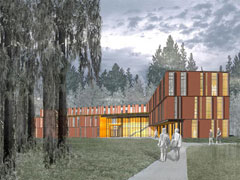 Poorly-ventilated buildings can sicken students and faculty, so improving it is essential to building a better campus. Many schools are now turning to natural ventilation methods to save energy and keep buildings safe. Two new buildings on Seattle-area campuses make for great examples. In both, natural ventilation systems take advantage of clean outdoor air, allowing windows to be opened and make room organic airflow patterns throughout the entire structure.
Poorly-ventilated buildings can sicken students and faculty, so improving it is essential to building a better campus. Many schools are now turning to natural ventilation methods to save energy and keep buildings safe. Two new buildings on Seattle-area campuses make for great examples. In both, natural ventilation systems take advantage of clean outdoor air, allowing windows to be opened and make room organic airflow patterns throughout the entire structure. -
Water recycling systems
 Wasting water is a major environmental issue, and one that colleges haven't ignored. Many have created systems that recycle and reuse both runoff and waste water on campus. One of the best examples of this is the state-of-the-art system UCLA employs. In LA, almost 90% of the water is imported from other areas, so school officials felt it was essential to make the most of it. The university does this through a variety of methods, including low-flow bathrooms, turning off foundations and air conditioning, anda high-tech cogeneration plant that recycles and reuses steam created for heat. Other schools harness rain water runoff to keep gardens and open spaces green.
Wasting water is a major environmental issue, and one that colleges haven't ignored. Many have created systems that recycle and reuse both runoff and waste water on campus. One of the best examples of this is the state-of-the-art system UCLA employs. In LA, almost 90% of the water is imported from other areas, so school officials felt it was essential to make the most of it. The university does this through a variety of methods, including low-flow bathrooms, turning off foundations and air conditioning, anda high-tech cogeneration plant that recycles and reuses steam created for heat. Other schools harness rain water runoff to keep gardens and open spaces green. -
Adaptive reuse of old buildings
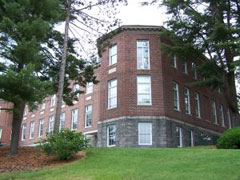 A new, totally green building on campus can be great for improving sustainability, but sometimes schools don't have the money or desire to tear down old ones. That's where adaptive reuse can come into play. Colleges can update and reuse older buildings to better serve the needs of modern students, which reduces waste and helps preserve a historic landmark for years to come. Amherst College is a school that embraces this idea, always trying to preserve old facilities rather than tear down and build new ones. It has reused and renovated seven different constructions using this principle.
A new, totally green building on campus can be great for improving sustainability, but sometimes schools don't have the money or desire to tear down old ones. That's where adaptive reuse can come into play. Colleges can update and reuse older buildings to better serve the needs of modern students, which reduces waste and helps preserve a historic landmark for years to come. Amherst College is a school that embraces this idea, always trying to preserve old facilities rather than tear down and build new ones. It has reused and renovated seven different constructions using this principle. -
Sustainable landscaping
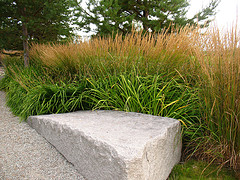 Part of creating a great college experience revolves around providing a campus that is attractive and pleasant to walk through. Yet in many places, this means using excess water to care for plants that aren't adapted to the sometimes harsh conditions. Schools are starting to take notice, and many embrace sustainable landscaping practices. This means, in most cases, that they've planted trees, shrubs, grasses and flowers native to the region and able to survive and thrive with little outside care and watering. Some of these projects also include rainwater collection, which partly or fully water campus gardens. Others are also offering on-site organic garden projects with the hope of serving healthier, more sustainable meals in the dorms.
Part of creating a great college experience revolves around providing a campus that is attractive and pleasant to walk through. Yet in many places, this means using excess water to care for plants that aren't adapted to the sometimes harsh conditions. Schools are starting to take notice, and many embrace sustainable landscaping practices. This means, in most cases, that they've planted trees, shrubs, grasses and flowers native to the region and able to survive and thrive with little outside care and watering. Some of these projects also include rainwater collection, which partly or fully water campus gardens. Others are also offering on-site organic garden projects with the hope of serving healthier, more sustainable meals in the dorms. -
Cool roofs
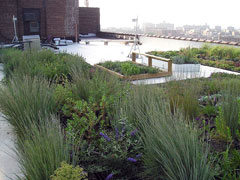 Cool roofs are catching on with many colleges around the country, especially those in hot or particularly sunny areas of the U.S. These constricts replace their traditional black asphalt predecessors, which absorb heat energy, with materials t reflecting the sun's light away from the building. This is usually accomplished by painting or shingling the roof with white or reflective materials. Cool roofing costs little to install, lasts for decades and can save schools tens of thousands of dollars each year. Not to mention millions of pounds of carbon emissions! Bren Hall on the campus of UC Santa Barbara is one such college building benefiting enjoying the new development. Covered in "white cap" sheet material (and an array of solar panels), the roof is part of an ultra-green building that scored the school two LEED platinum certifications.
Cool roofs are catching on with many colleges around the country, especially those in hot or particularly sunny areas of the U.S. These constricts replace their traditional black asphalt predecessors, which absorb heat energy, with materials t reflecting the sun's light away from the building. This is usually accomplished by painting or shingling the roof with white or reflective materials. Cool roofing costs little to install, lasts for decades and can save schools tens of thousands of dollars each year. Not to mention millions of pounds of carbon emissions! Bren Hall on the campus of UC Santa Barbara is one such college building benefiting enjoying the new development. Covered in "white cap" sheet material (and an array of solar panels), the roof is part of an ultra-green building that scored the school two LEED platinum certifications. -
LEED certification for all new buildings
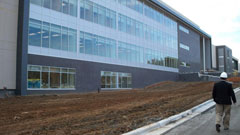 For most colleges adding new buildings today, LEED certification is a badge of honor. Not only does it save the school money over time, but it can be a major draw for students looking for universities harboring a more eco-conscious outlook. While most major campuses across the U.S. have at least one LEED certified building, some schools, like Wake Technical Community College, are taking it to the extreme. Wake aims to be an all-LEED leader, with buildings employing many of the green design trends seen here. Could its approach be a sign of what's to come? Only time will tell, but with current trends perpetuated by today's sustainable schools, it's looking more and more promising.
For most colleges adding new buildings today, LEED certification is a badge of honor. Not only does it save the school money over time, but it can be a major draw for students looking for universities harboring a more eco-conscious outlook. While most major campuses across the U.S. have at least one LEED certified building, some schools, like Wake Technical Community College, are taking it to the extreme. Wake aims to be an all-LEED leader, with buildings employing many of the green design trends seen here. Could its approach be a sign of what's to come? Only time will tell, but with current trends perpetuated by today's sustainable schools, it's looking more and more promising.
in this article we are sharing the details of JEE Main Admit Card 2020.click here to know more necessary details
ReplyDeleteStephen Hawking Net Worth Hello there, I found your blog by means of Google even as searching for a related matter, your website came up, it appears good. I’ve bookmarked it in my google bookmarks.
ReplyDeleteStephen Hawking Biography I must say, as a lot as I enjoyed reading what you had to say, I couldn't help but lose interest after a while. Its as if you had a wonderful grasp on the subject matter, but you forgot to include your readers. Perhaps you should think about this from far more than one angle. Or maybe you shouldn't generalize so considerably. Its better if you think about what others may have to say instead of just going for a gut reaction to the subject. Think about adjusting your own believed process and giving others who may read this the benefit of the doubt.
ReplyDelete